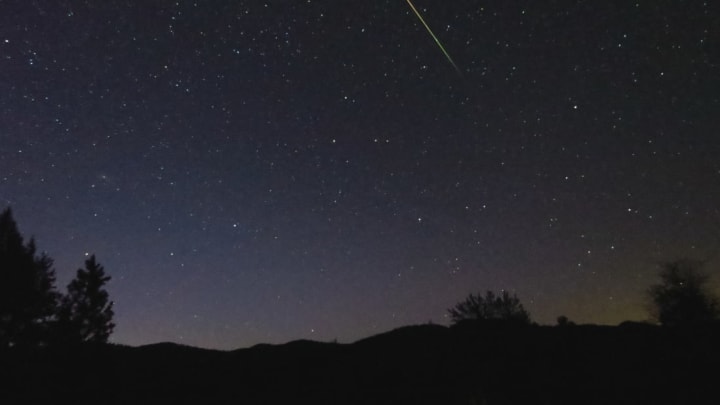Set your alarm for the predawn hours of Saturday May 6, go outside, and catch the Eta Aquarid meteor shower—one of two annual showers caused by the collision of the Earth and the debris field of Halley’s comet. It’s not the most spectacular shower of the year, but as it peaks tomorrow morning, you can count on it to deliver a ghostly streak of light every few minutes.
The shower is named for its seeming point of origin—the constellation Aquarius—but don’t confine your view to that one spot in the sky. The streaks of light will seem to be everywhere. If your eyes have adjusted to the darkness, the skies are clear, and the area is sufficiently dark, there’s an excellent chance you’ll see something special—no telescope or binoculars required.
HALLEY’S PHANTASM
Going back millennia, every 75 to 76 years the comet Halley has appeared in the sky, dazzling and mystifying the creatures of Earth. As of 1986—its last appearance over Earth—it was visible with the naked eye despite light pollution caused by poorly designed streetlights, ill-conceived fixtures, and the over and upward illumination of buildings in areas rural and urban alike. Most of us have never seen the night sky, but rather, some poor, washed out approximation of it. You look up, think you see space, and wonder why we’re spending so much money to visit so little. A proper night sky is a kaleidoscope of greens, blues, teals, and violets. There are more stars out there than grains of sand on the Earth. The first time you see the Milky Way in all its splendor, you may wonder why we do anything other than explore the cosmos.

All of this bears note because for most of Halley’s history, there were no electric lights to outshine the universe. There were no planes or space stations to make illuminated objects coursing across the sky humdrum affairs filtered from thought. When something moved in the night sky back then, it was stark, obvious, and unnerving. Today we see a meteor shower and wonder how long the faint show might last. Centuries ago, people saw meteor showers and wondered if the world were about to end. The first recorded showing of Halley was possibly in 476 BCE. Aeschylus hadn’t yet written Agamemnon. The Roman Republic was in its infancy. Its recurrence has been associated with the birth of Jesus (its appearance may have coincided with the Star of Bethlehem), has been seen as a harbinger of death for royalty, and was a guiding light for Genghis Khan. Astronomy has always been as much about humanity as it is about the cosmos.
HOW TO MAKE A METEOR
The same dark skies unobscured by light pollution would have made the Aquarids—and every meteor shower to some extent—must-see viewing. Its first recorded observance was in 401 CE (the Roman Empire still stood then), and it was officially discovered in 1870. Six years later, it was calculated that the parent of the meteor shower was none other than the famed comet Halley, and people really started taking notice. As a comet travels along its orbit, it leaves a fine debris field in its wake. The Earth, happy and oblivious along its orbit, eventually crosses into the field of dust and sand-sized particles that were once part of Halley, and the result is a meteor shower: specks of dust slamming into the Earth’s atmosphere at tens of thousands of miles per hour. As they are vaporized, energy is released, producing those famed streaks of light in the night sky. (Later in Earth’s orbit, it will encounter Halley’s debris field again: the Orionids in October.)
So how can you see the phantom trail of Halley’s comet? The most exciting way is to wake a couple of hours before dawn, lay out a blanket in some dark area, and look up. Once your eyes adjust, you should be able to catch about 10 meteors per hour. If that’s too much work for you—it’s hot out there, and mosquitoes, you know?—Slooh will be broadcasting the meteor shower live, with running commentary by astronomers.
